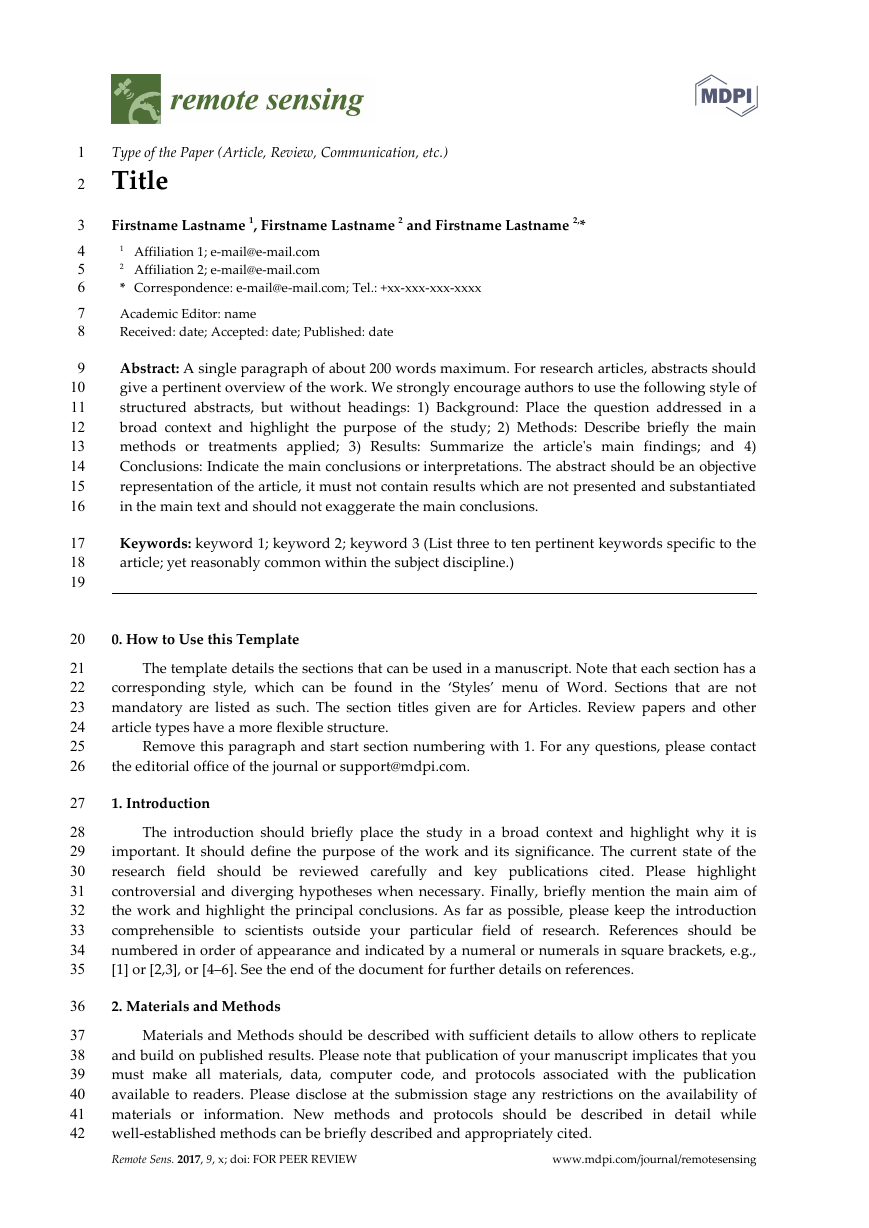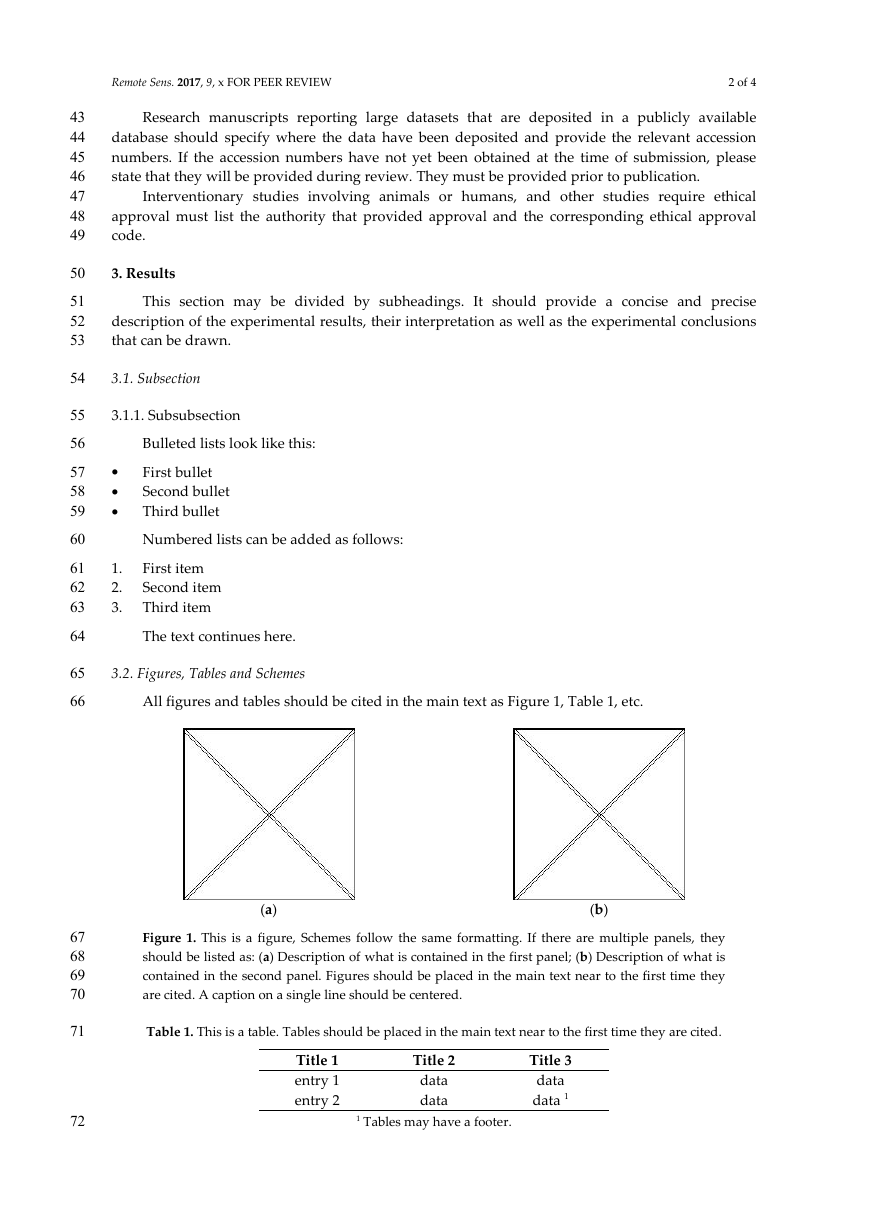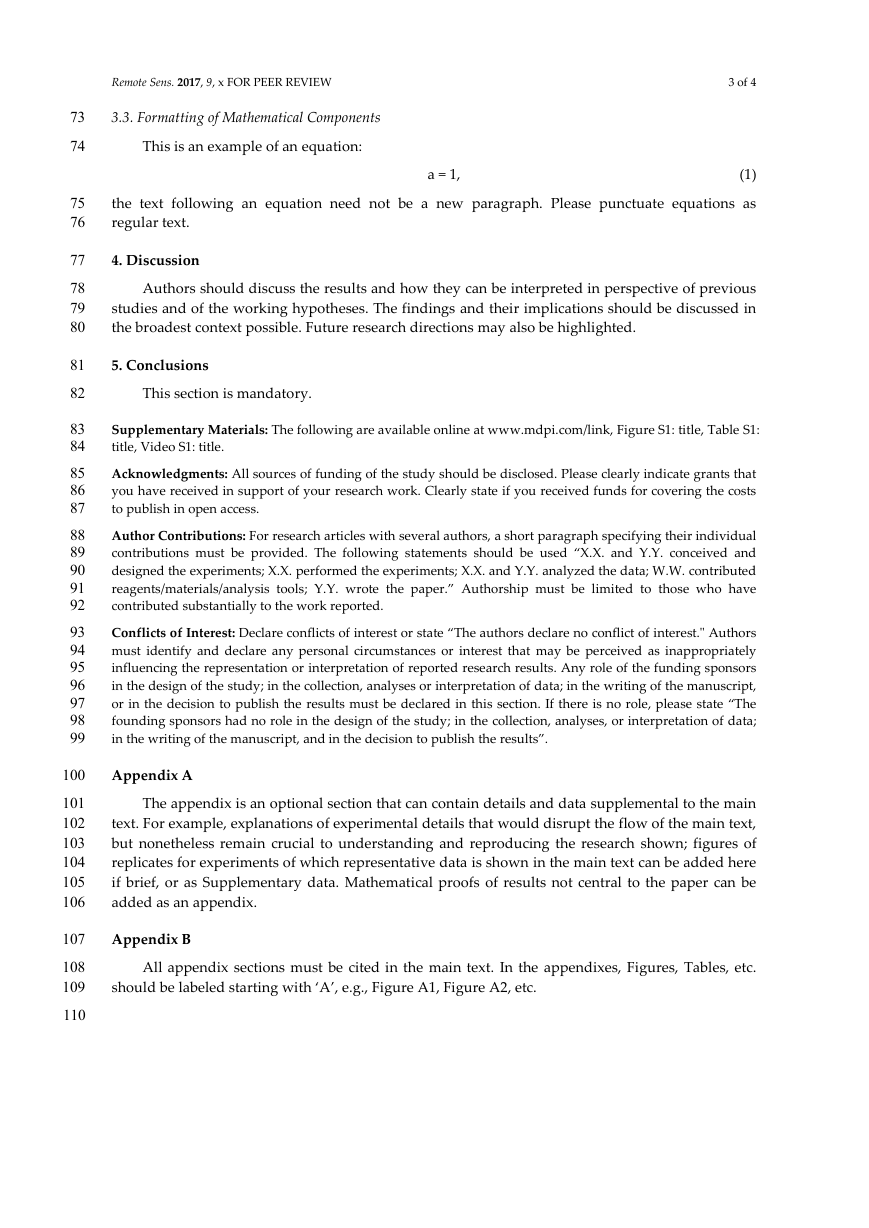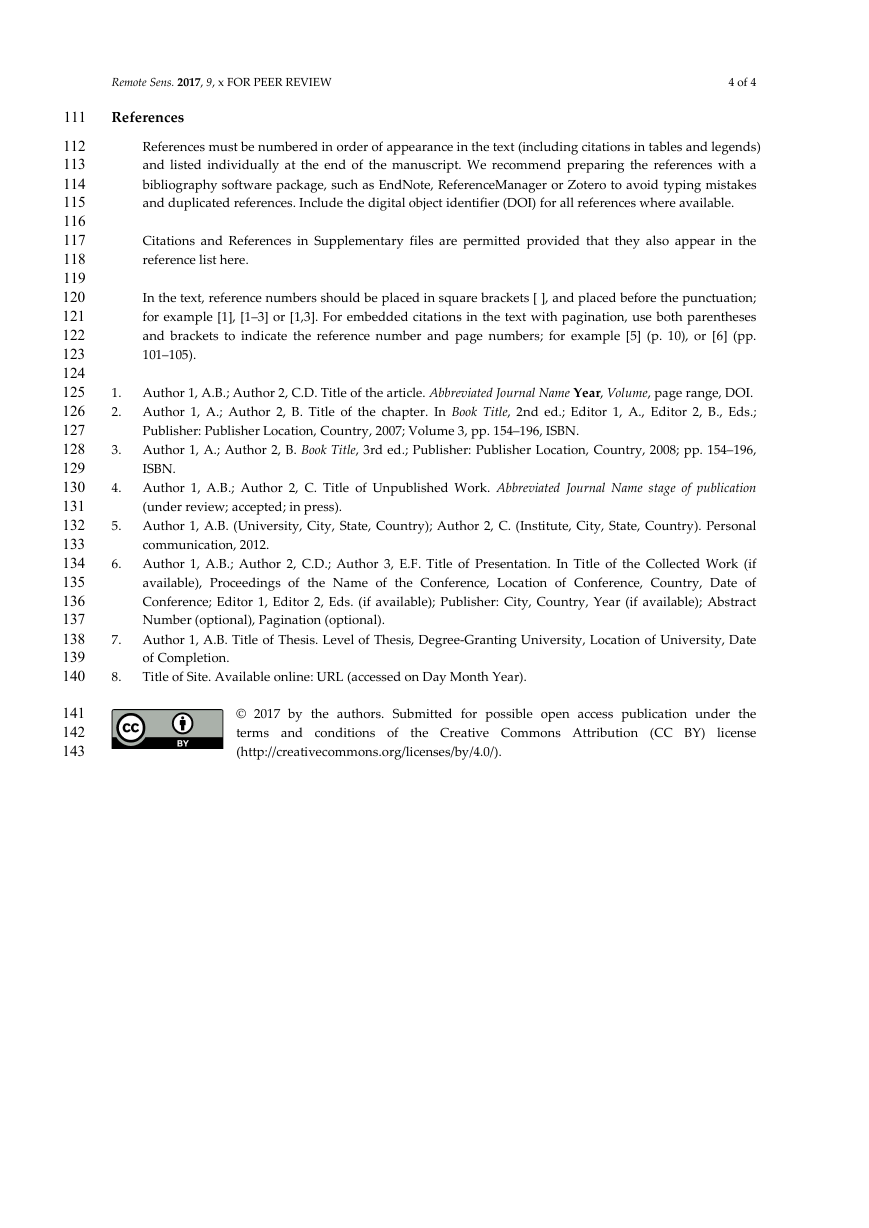1
2
3
4
5
6
7
8
9
10
11
12
13
14
15
16
17
18
19
20
21
22
23
24
25
26
27
28
29
30
31
32
33
34
35
36
37
38
39
40
41
42
Type of the Paper (Article, Review, Communication, etc.)
Title
Firstname Lastname 1, Firstname Lastname 2 and Firstname Lastname 2,*
1 Affiliation 1; e-mail@e-mail.com
2 Affiliation 2; e-mail@e-mail.com
* Correspondence: e-mail@e-mail.com; Tel.: +xx-xxx-xxx-xxxx
Academic Editor: name
Received: date; Accepted: date; Published: date
Abstract: A single paragraph of about 200 words maximum. For research articles, abstracts should
give a pertinent overview of the work. We strongly encourage authors to use the following style of
structured abstracts, but without headings: 1) Background: Place the question addressed in a
broad context and highlight the purpose of the study; 2) Methods: Describe briefly the main
methods or treatments applied; 3) Results: Summarize the article's main findings; and 4)
Conclusions: Indicate the main conclusions or interpretations. The abstract should be an objective
representation of the article, it must not contain results which are not presented and substantiated
in the main text and should not exaggerate the main conclusions.
Keywords: keyword 1; keyword 2; keyword 3 (List three to ten pertinent keywords specific to the
article; yet reasonably common within the subject discipline.)
0. How to Use this Template
The template details the sections that can be used in a manuscript. Note that each section has a
corresponding style, which can be found in the ‘Styles’ menu of Word. Sections that are not
mandatory are listed as such. The section titles given are for Articles. Review papers and other
article types have a more flexible structure.
Remove this paragraph and start section numbering with 1. For any questions, please contact
the editorial office of the journal or support@mdpi.com.
1. Introduction
The introduction should briefly place the study in a broad context and highlight why it is
important. It should define the purpose of the work and its significance. The current state of the
research field should be reviewed carefully and key publications cited. Please highlight
controversial and diverging hypotheses when necessary. Finally, briefly mention the main aim of
the work and highlight the principal conclusions. As far as possible, please keep the introduction
comprehensible to scientists outside your particular field of research. References should be
numbered in order of appearance and indicated by a numeral or numerals in square brackets, e.g.,
[1] or [2,3], or [4–6]. See the end of the document for further details on references.
2. Materials and Methods
Materials and Methods should be described with sufficient details to allow others to replicate
and build on published results. Please note that publication of your manuscript implicates that you
must make all materials, data, computer code, and protocols associated with the publication
available to readers. Please disclose at the submission stage any restrictions on the availability of
materials or information. New methods and protocols should be described in detail while
well-established methods can be briefly described and appropriately cited.
Remote Sens. 2017, 9, x; doi: FOR PEER REVIEW
www.mdpi.com/journal/remotesensing
�
Remote Sens. 2017, 9, x FOR PEER REVIEW
2 of 4
Research manuscripts reporting large datasets that are deposited in a publicly available
database should specify where the data have been deposited and provide the relevant accession
numbers. If the accession numbers have not yet been obtained at the time of submission, please
state that they will be provided during review. They must be provided prior to publication.
Interventionary studies involving animals or humans, and other studies require ethical
approval must list the authority that provided approval and the corresponding ethical approval
code.
3. Results
This section may be divided by subheadings. It should provide a concise and precise
description of the experimental results, their interpretation as well as the experimental conclusions
that can be drawn.
3.1. Subsection
3.1.1. Subsubsection
1.
2.
3.
Bulleted lists look like this:
First bullet
Second bullet
Third bullet
Numbered lists can be added as follows:
First item
Second item
Third item
The text continues here.
3.2. Figures, Tables and Schemes
All figures and tables should be cited in the main text as Figure 1, Table 1, etc.
(a)
(b)
Figure 1. This is a figure, Schemes follow the same formatting. If there are multiple panels, they
should be listed as: (a) Description of what is contained in the first panel; (b) Description of what is
contained in the second panel. Figures should be placed in the main text near to the first time they
are cited. A caption on a single line should be centered.
Table 1. This is a table. Tables should be placed in the main text near to the first time they are cited.
Title 1
entry 1
entry 2
Title 2
data
data
Title 3
data
data 1
1 Tables may have a footer.
43
44
45
46
47
48
49
50
51
52
53
54
55
56
57
58
59
60
61
62
63
64
65
66
67
68
69
70
71
72
�
Remote Sens. 2017, 9, x FOR PEER REVIEW
3.3. Formatting of Mathematical Components
This is an example of an equation:
3 of 4
(1)
the text following an equation need not be a new paragraph. Please punctuate equations as
regular text.
a = 1,
4. Discussion
Authors should discuss the results and how they can be interpreted in perspective of previous
studies and of the working hypotheses. The findings and their implications should be discussed in
the broadest context possible. Future research directions may also be highlighted.
5. Conclusions
This section is mandatory.
Supplementary Materials: The following are available online at www.mdpi.com/link, Figure S1: title, Table S1:
title, Video S1: title.
Acknowledgments: All sources of funding of the study should be disclosed. Please clearly indicate grants that
you have received in support of your research work. Clearly state if you received funds for covering the costs
to publish in open access.
Author Contributions: For research articles with several authors, a short paragraph specifying their individual
contributions must be provided. The following statements should be used “X.X. and Y.Y. conceived and
designed the experiments; X.X. performed the experiments; X.X. and Y.Y. analyzed the data; W.W. contributed
reagents/materials/analysis tools; Y.Y. wrote the paper.” Authorship must be limited to those who have
contributed substantially to the work reported.
Conflicts of Interest: Declare conflicts of interest or state “The authors declare no conflict of interest." Authors
must identify and declare any personal circumstances or interest that may be perceived as inappropriately
influencing the representation or interpretation of reported research results. Any role of the funding sponsors
in the design of the study; in the collection, analyses or interpretation of data; in the writing of the manuscript,
or in the decision to publish the results must be declared in this section. If there is no role, please state “The
founding sponsors had no role in the design of the study; in the collection, analyses, or interpretation of data;
in the writing of the manuscript, and in the decision to publish the results”.
Appendix A
The appendix is an optional section that can contain details and data supplemental to the main
text. For example, explanations of experimental details that would disrupt the flow of the main text,
but nonetheless remain crucial to understanding and reproducing the research shown; figures of
replicates for experiments of which representative data is shown in the main text can be added here
if brief, or as Supplementary data. Mathematical proofs of results not central to the paper can be
added as an appendix.
Appendix B
All appendix sections must be cited in the main text. In the appendixes, Figures, Tables, etc.
should be labeled starting with ‘A’, e.g., Figure A1, Figure A2, etc.
73
74
75
76
77
78
79
80
81
82
83
84
85
86
87
88
89
90
91
92
93
94
95
96
97
98
99
100
101
102
103
104
105
106
107
108
109
110
�
Remote Sens. 2017, 9, x FOR PEER REVIEW
4 of 4
References
References must be numbered in order of appearance in the text (including citations in tables and legends)
and listed individually at the end of the manuscript. We recommend preparing the references with a
bibliography software package, such as EndNote, ReferenceManager or Zotero to avoid typing mistakes
and duplicated references. Include the digital object identifier (DOI) for all references where available.
Citations and References in Supplementary files are permitted provided that they also appear in the
reference list here.
In the text, reference numbers should be placed in square brackets [ ], and placed before the punctuation;
for example [1], [1–3] or [1,3]. For embedded citations in the text with pagination, use both parentheses
and brackets to indicate the reference number and page numbers; for example [5] (p. 10), or [6] (pp.
101–105).
1.
2.
3.
4.
5.
6.
7.
8.
Author 1, A.B.; Author 2, C.D. Title of the article. Abbreviated Journal Name Year, Volume, page range, DOI.
Author 1, A.; Author 2, B. Title of the chapter. In Book Title, 2nd ed.; Editor 1, A., Editor 2, B., Eds.;
Publisher: Publisher Location, Country, 2007; Volume 3, pp. 154–196, ISBN.
Author 1, A.; Author 2, B. Book Title, 3rd ed.; Publisher: Publisher Location, Country, 2008; pp. 154–196,
ISBN.
Author 1, A.B.; Author 2, C. Title of Unpublished Work. Abbreviated Journal Name stage of publication
(under review; accepted; in press).
Author 1, A.B. (University, City, State, Country); Author 2, C. (Institute, City, State, Country). Personal
communication, 2012.
Author 1, A.B.; Author 2, C.D.; Author 3, E.F. Title of Presentation. In Title of the Collected Work (if
available), Proceedings of the Name of the Conference, Location of Conference, Country, Date of
Conference; Editor 1, Editor 2, Eds. (if available); Publisher: City, Country, Year (if available); Abstract
Number (optional), Pagination (optional).
Author 1, A.B. Title of Thesis. Level of Thesis, Degree-Granting University, Location of University, Date
of Completion.
Title of Site. Available online: URL (accessed on Day Month Year).
© 2017 by the authors. Submitted for possible open access publication under the
terms and conditions of
license
(http://creativecommons.org/licenses/by/4.0/).
the Creative Commons Attribution (CC BY)
111
112
113
114
115
116
117
118
119
120
121
122
123
124
125
126
127
128
129
130
131
132
133
134
135
136
137
138
139
140
141
142
143
�








 2023年江西萍乡中考道德与法治真题及答案.doc
2023年江西萍乡中考道德与法治真题及答案.doc 2012年重庆南川中考生物真题及答案.doc
2012年重庆南川中考生物真题及答案.doc 2013年江西师范大学地理学综合及文艺理论基础考研真题.doc
2013年江西师范大学地理学综合及文艺理论基础考研真题.doc 2020年四川甘孜小升初语文真题及答案I卷.doc
2020年四川甘孜小升初语文真题及答案I卷.doc 2020年注册岩土工程师专业基础考试真题及答案.doc
2020年注册岩土工程师专业基础考试真题及答案.doc 2023-2024学年福建省厦门市九年级上学期数学月考试题及答案.doc
2023-2024学年福建省厦门市九年级上学期数学月考试题及答案.doc 2021-2022学年辽宁省沈阳市大东区九年级上学期语文期末试题及答案.doc
2021-2022学年辽宁省沈阳市大东区九年级上学期语文期末试题及答案.doc 2022-2023学年北京东城区初三第一学期物理期末试卷及答案.doc
2022-2023学年北京东城区初三第一学期物理期末试卷及答案.doc 2018上半年江西教师资格初中地理学科知识与教学能力真题及答案.doc
2018上半年江西教师资格初中地理学科知识与教学能力真题及答案.doc 2012年河北国家公务员申论考试真题及答案-省级.doc
2012年河北国家公务员申论考试真题及答案-省级.doc 2020-2021学年江苏省扬州市江都区邵樊片九年级上学期数学第一次质量检测试题及答案.doc
2020-2021学年江苏省扬州市江都区邵樊片九年级上学期数学第一次质量检测试题及答案.doc 2022下半年黑龙江教师资格证中学综合素质真题及答案.doc
2022下半年黑龙江教师资格证中学综合素质真题及答案.doc